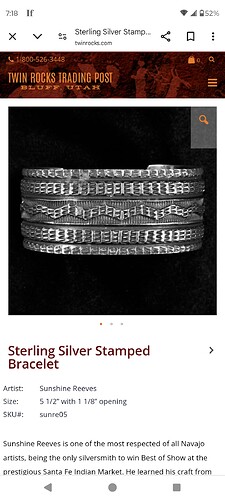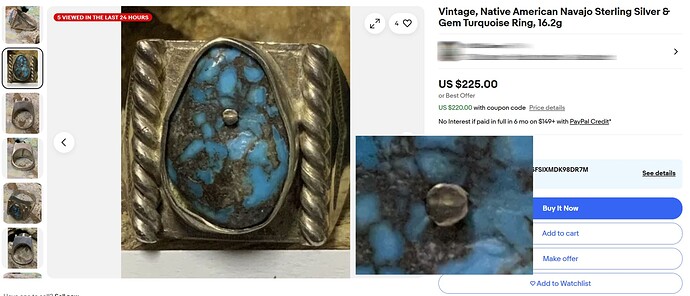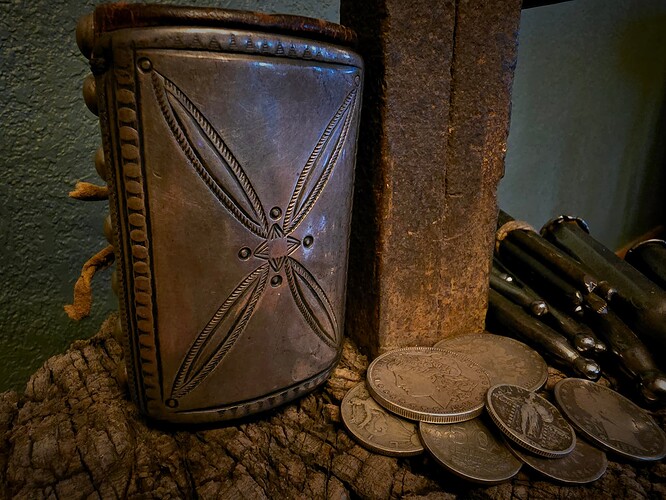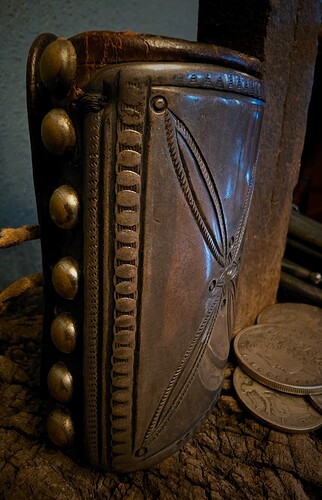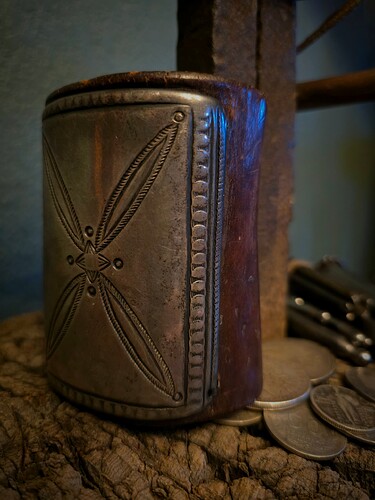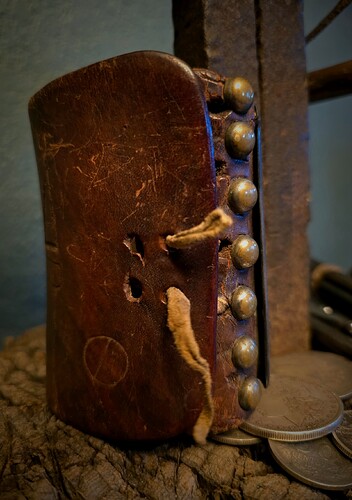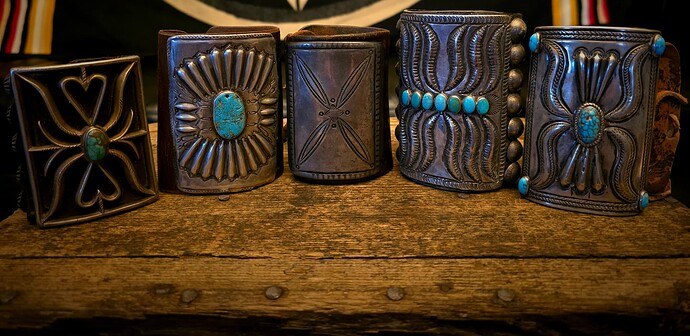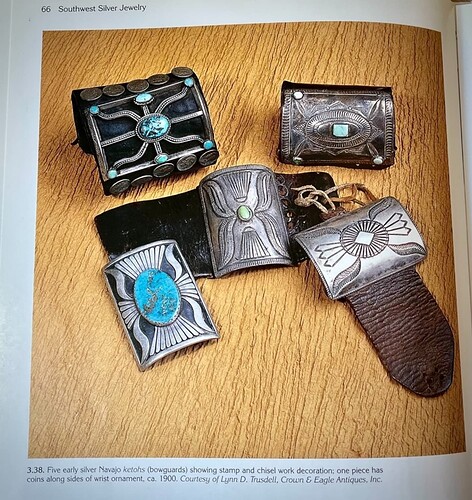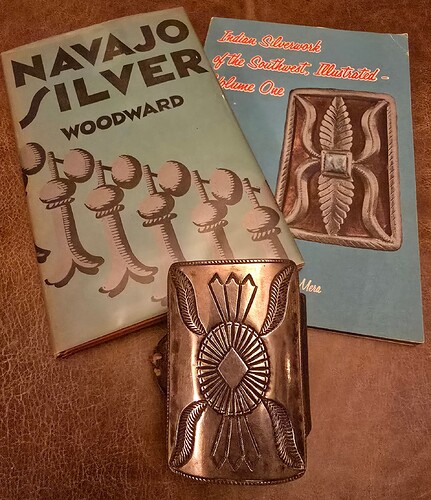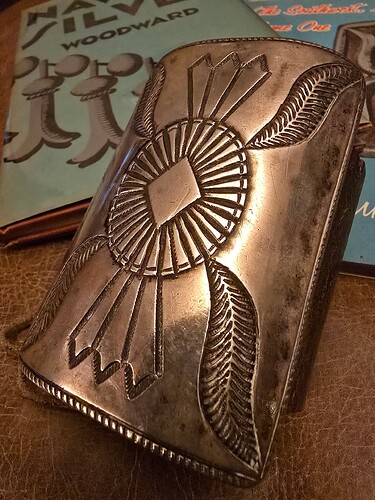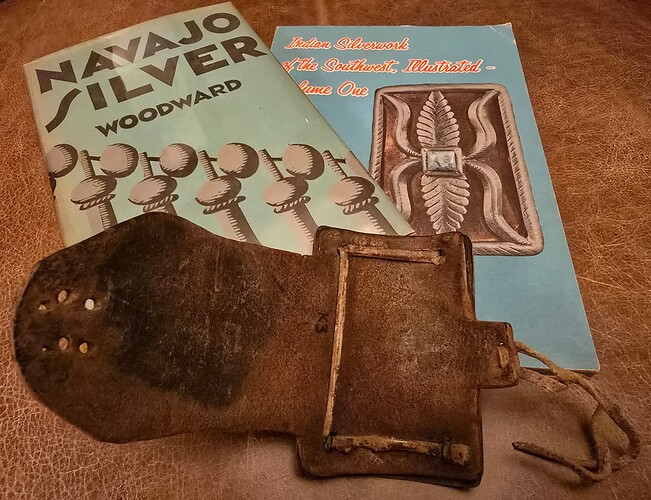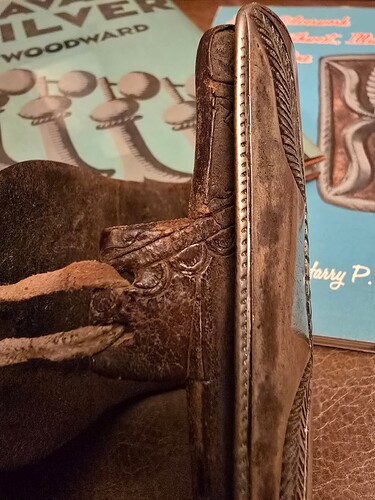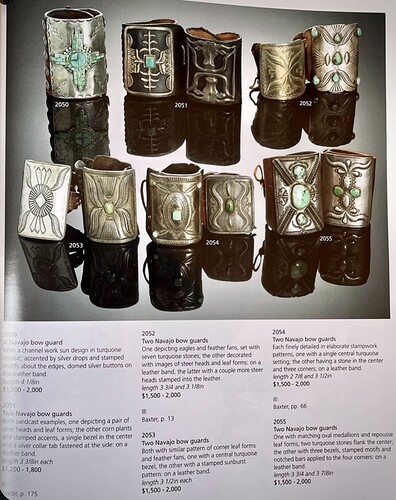At 200 grams, it sold for $835…a very good deal. My hubby just retired so I have to reign in the spending a bit. it’s worth well over $1000. I love the stamping and would like to purchase something more in my price range…perhaps a smaller box. Thanks @ TAH for your suggestion too.
Holy buckets!! $8000 for Sunshine Reeves stamped box. Should have…could have….bid more and won that item. Oh well.
This is the one at Twin Rocks. It might be somewhat too big, and there’s another one I’m really keeping my eye on.
Very lovely. the stamping gives it a cast kind of look! If you see some great stamping by newer artists on your travels, take note please and send along their names!
Thank you for sharing, Steve. It’s a beautiful stone, the hole is a plus, and I like the stampwork on the side of the band. ![]() Unfortunately, it wouldn’t fit any of my ogre fingers.
Unfortunately, it wouldn’t fit any of my ogre fingers.
Adding to the list of artists well known for their stamp work: Norbert Peshlakai, Jennifer and Thomas Curtis, Curtis Pete, and Lyndon Tsosie all come to mind.
This one has been in the works for quite some time. There was a fair amount of conversation, multiple photos shared, as well as some due diligence on my end that needed to be performed.
The leather is quite thick and surprisingly malleable, and with it’s severely rolled edges and beautiful surface finish, this wristband was well loved and worn often, I feel. I think the multiple holes to accompany a larger wrist are a neat aspect, and play to this ketoh’s experiences.
The amount of honest wear that this one presents with is fascinating, to me. The corners have been drastically rolled and worn through the stampwork, thinning the silver at some points. Two (what are believed to be later) punched holes exist in opposing corners, apparently executed in an attempt to secure the ketoh to the leather, as the original loops had obviously failed at some point. The heavily worn brass buttons provide an oddly satisfying bit of contrast to the leather and dark silver.
This is the first ketoh under my care that bears neither complex stampwork or turquoise. I must say, in my opinion, this one’s beauty is in it’s simplicity.
Navajo, Late First Phase, ca. 1880-1890, 3 1/2" x 3", 160 grams
Definitely one of the finest.
Aaron,
This ketoh has it all. As you mentioned, honest wear in all the right places, simple tasteful stamp work, no nonsense brass buttons, and rolled edges on the silver and original leather. Add in late 19th century date of creation and you have a museum worthy, work of art. As always, your photography is superb.
Thank you, @StevesTrail and @TAH, for your kind words. I’m glad you guys enjoyed!
Love this! Not only is it beautiful, I love silver on leather.
I’d taken this photo when sharing the most recent content, and decided against posting it as I was annoyed that the pattern of the blanket in the background is off center. If my negligence to provide tasteful composition can be forgiven, perhaps this group shot of ketohs will prove enjoyable.
Wonderful collection of everything. How long have you been collecting?
Wow! They’re all beautiful. My favorite is the one on the left with the heart shapes. But what am I saying, I love them all!
The turquoise is all lovely, but the webbing in the far right stone is really special, and the color change in the turquoise on the left of that is perfect. They look like they would be heavy to wear. Are they?
Thank you @StevesTrail.
I’ve been a student of culture for most of my life, and have collected coastal Arctic and Pacific Northwest art since spending time in Oregon, Washington, and Alaska, that’s been about ten years ago. I’ve really gotten passionate about Navajo silver within the last five, I’d say. Thank you for your interest!
Good morning, @Ziacat.
As you well know, your favorite is sandcast, ca. 1930. The example on the far right contains five #8 turquoise cabs, also ca. 1930. The color change on the stones you mention is one of my favorite things about that ketoh, that one’s ca. 1935.
Not really, I’ve owned cuffs that weigh more, the average weight of these is 150-175 grams.
Of course I’m drawn to the sand cast! The other cuff I was looking at on vacation was tufa cast, and I thought, I really need to get something different ![]()
My favorite is the group! ![]() The order in which they are displayed is symmetrically pleasing, as well. I’m still deciding if I will forgive you on the off center background.
The order in which they are displayed is symmetrically pleasing, as well. I’m still deciding if I will forgive you on the off center background. ![]()
In 2009, on the first of June, Bonham’s held an auction of property from Lynn D. Trusdell’s estate. It contained some of the finest examples of early Navajo silver, and was (so I’ve been told and can imagine) a very exciting and thrilling event. The auction catalogue is just a joy to view.
This ketoh was collected by Lynn and later published in Paula Baxter’s Southwest Silver Jewelry: The First Century, 2001.
To me, on these earlier pieces, original leather is important, (or at least what can be perceived as very early leather) I feel it really adds to the piece. The reduced width shank at the thongs is a neat touch and I really like the hand tooled portion, it makes me ponder on what awesome article of Western leather was cut up for this ketoh. ![]()
Navajo, ca. 1900, 3 1/2" x 2 1/2", 150 grams
From the Bonham’s catalogue.
